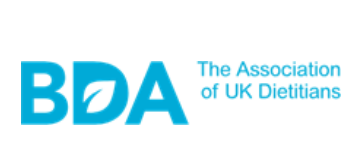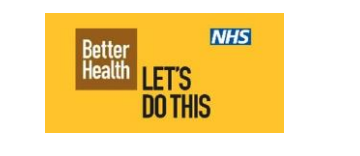How to lose weight in a healthy way
Could you benefit from
losing some weight?
Use a BMI calculator to
find out if you are in the
healthy weight,
overweight or obese
BMI range
About 63% of UK adults are living with overweight or obesity.
If this includes you, we know that losing just 5 – 10% of your
weight has positive health benefits including reduced risk of
type 2 diabetes, heart disease, and some cancers.
Losing inches from your waist also helps lower your risk of
obesity related conditions.
Where to start?
Ask yourself “Am I ready to commit to
weight loss now?” If you are, this
leaflet can get you started. If now isn’t
the right time for you, come back to
this leaflet when you do feel ready.
Set yourself specific but realistic goals, e.g.
Add 1 extra fruit or veg portion per day (in time
increase again to achieve at least 5-a-day)
Swap meat for lentils or beans one day a week
Get weighed once a week on Wednesdays
Avoid “fad diets” with no scientific basis. Many fad diets will lead to initial weight loss, but often
lean muscle and fluid is lost rather than fat loss. Fad diets cannot usually be followed long term
because of the rigid rules and limits. See: https://www.bda.uk.com/resource/fad-diets.html
Aim for realistic weight loss: 1 – 2 pounds (0.5 – 1kg) per week or 5 – 10% over 3 to 6 months.
Consider keeping a food & drinks diary or tracking calories: use a notebook or digital tool (e.g. MyFitnessPal, Nutracheck or NHS Weight Loss Plan) to record your eating habits.
Include all the food groups in your diet and aim to eat three balanced meals daily: fruits & vegetables, starchy carbohydrates (e.g. rice, bread, pasta, potatoes), dairy or non-dairy plant- based options (e.g. cheese, milk, yoghurt), protein sources (e.g. meat, fish, eggs, beans & pulses, tofu), small amounts of unsaturated fats (e.g. sunflower, rapeseed, vegetable or olive oil). See: https://www.nhs.uk/live-well/eat-well/food-guidelines-and-food-labels/the-eatwell-guide
Be snack aware: include nutritious snacks in your diet but only if you are physically hungry e.g. portion of fruit, vegetable sticks with hummus, low fat yoghurt, 30g low fat cheese, a hard-boiled egg, small handful of unsalted nuts. See: https://www.bda.uk.com/resource/healthy-snacks.html
Control your portions: keeping your portions to recommended sizes helps to limit over-eating. Check food packaging and recipes for suggested serving sizes. See: https://www.nutrition.org.uk/creating-a-healthy-diet/portion-sizes
Try the “plate method”: fill up half your plate with vegetables or salad, one quarter with protein sources and one quarter with starchy carbohydrates. Try using a smaller plate for main meals.
Check food labels: choose lower-sugar / lower-fat options, aim for green or amber options on traffic-light style food labels and avoid or limit red options, which are higher in fat, sugar or salt. See: https://www.bda.uk.com/resource/food-labelling-nutrition-information.html
Make smart swaps: choose wholegrain options for extra fibre which keeps you feeling full for longer; swap some meat for beans, lentils or chickpeas which are protein-packed and full of fibre but lower in fat; swap sugary drinks for zero-calorie options or flavoured water. See: https://www.nhs.uk/healthier-families/food-facts/healthier-food-swaps
Limit alcohol: alcohol is high in calories, fills us up and can lead us to make poor choices. If you drink, consider swapping to low or non-alcoholic drinks and follow recommendations for limiting alcohol to 14 units per week. See: https://www.drinkaware.co.uk/
Monitor your progress: evidence shows that people who weigh themselves once or twice a week lose more weight. If you’d rather not get weighed, you could record how your clothes fit, measure around your waist, upper arms or thighs or take photos of yourself to see changes over time.
Follow the 80:20 approach: choose a healthier lifestyle 80% of the time and allow yourself more flexibility for the other 20%. Remember, food is more than just nutrients and should be enjoyed.
Help yourself to stay on track
For eating out: check menus ahead of time to choose healthier options before you feel hungry
For busy days: meal plan or food prep in advance, batch cook and make use of leftovers
For days that don’t go to plan: avoid “all-or-nothing” thinking, it’s likely that some days you won’t stick to your plan but that doesn’t mean the rest of the week has to be a failure, just get back to your plan as soon as possible, start over and keep moving forward towards your goals.
NHS Weight Loss Plan app (gives 12-weeks of support with food or calorie tracking plus advice on making healthier choices): https://www.nhs.uk/better-health/lose-weight/
Norfolk County Council “Ready to Change” (learn the benefits of achieving and maintaining a healthy weight, practical weight loss tips, and how to set realistic goals, either self-guided or sign up for a 30-day Health Challenge): https://www.norfolk.gov.uk/article/42173/How-to-lose-weight
Feel Good Suffolk “Healthy Weight” (website advice available to all, targeted support only available to Suffolk residents over 18 years old with BMI 27.5 – 30 or higher): https://feelgoodsuffolk.co.uk/healthy-weight/
For adults living with obesity who also have a diagnosis of diabetes, hypertension or both:
The NHS Digital Weight Management Programme (GP / Pharmacist referral required to join a 12-week online behavioural and lifestyle programme accessed via a smartphone or computer with internet access): https://www.england.nhs.uk/digital-weight-management/
Visit (or click on) these websites for more weight loss and nutrition information or healthy recipes:



